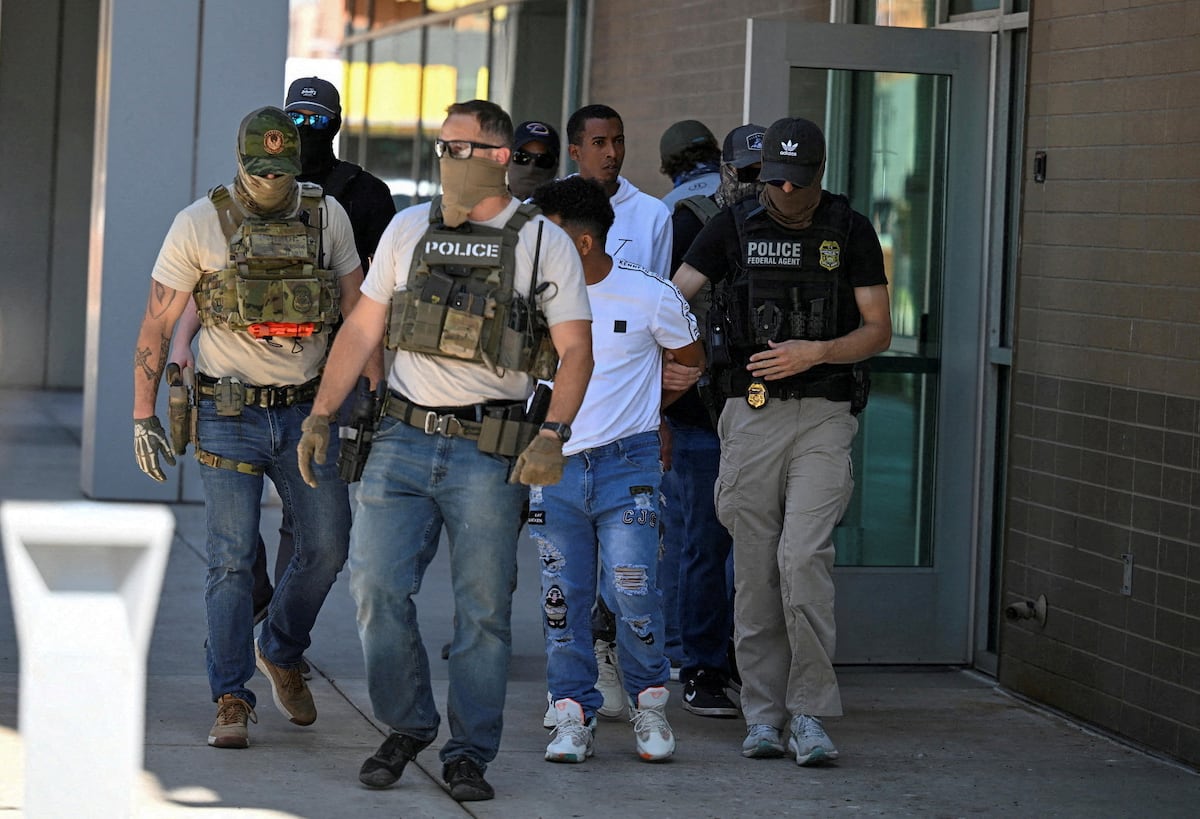The unprecedented attacks on the Latino community since Donald Trump returned to the White House could be supported by the Supreme Court if it rules in favor of the administration on an emergency request from the Department of Homeland Security to allow speaking Spanish or having a Latino appearance to provide sufficient grounds for detention by Immigration and Customs Enforcement (ICE).
Latino organizations warn of the potential effects of a ruling in favor of the Trump administration. “This will increase insecurity and worsen the situation for the Latino community in ways we haven’t seen since the 1930s, when mass deportations of Latinos took place. We’re talking about something that could be historic and could have a very negative impact on the Latino community,” warns Cristobal Ramón, immigration policy advisor for UnidosUS.
The administration has appealed to the Supreme Court — which has sided with it on several of its controversial immigration measures — to overturn a ruling by a California district judge. In July, the judge temporarily banned officers from stopping people based on racial profiling. Her ruling applies to the state’s Central District, which covers the Los Angeles metropolitan area, where nearly half the population is Latino. An appeals court upheld the ban, prompting the administration to appeal to the Supreme Court last week.
“The district court’s injunction significantly interferes with federal enforcement efforts in a region that is larger and more populated than many countries and has become a major epicenter of the immigration crisis,” the government representative said in the papers filed with the Supreme Court.
The Department of Homeland Security (DHS) is requesting that ICE be able to use race or ethnicity; speaking Spanish or English with an accent; being present in certain locations (bus stops, car washes, parking lots, etc.), or performing certain jobs (day laborer, construction worker, gardener, street vendor, etc.) as factors to suspect a person is undocumented.
Los Angeles Central District Judge Maame E. Frimpong ordered ICE to stop making arrests based on these factors. In doing so, she sided with several individuals and civil rights organizations who complained that agents used racial profiling to detain even U.S. citizens. Some of them are parties to the lawsuit.
This is the case of Jason Brian Gavidia, a Latino born in Los Angeles. On June 12, armed officers confronted him on the sidewalk beside a tow truck where he was having his car repaired. A masked officer asked him if he was a citizen, to which he replied affirmatively. The officer repeatedly asked which hospital he was born in, and Gavidia replied that he didn’t know. Afterward, with the help of a colleague, they slammed him against a metal fence, placed his hands behind his back, twisted his arm, and took his phone. Gavidia showed them his ID, and they released him.
In her ruling, Frimpong held that ICE lacked a legitimate basis to detain most of the people arrested in its Los Angeles operations. She concluded that the operations constituted a “threatening presence” that caused people to fear they were being “kidnapped.”
Under pressure to comply with the president’s wishes in seeking to carry out the largest deportation in history during his second term, ICE launched a massive, indiscriminate raid around Los Angeles in early summer, sparking numerous protests among the population. To mitigate these protests, Trump ordered the deployment of Marines and the National Guard to the California city.
Chandra S. Bhatnagar, executive director of the American Civil Liberties Union (ACLU) of Southern California, said after Frimpong’s ruling that “since June 6, more than 2,300 people — workers, students, mothers, fathers, grandparents, and residents across the South — have been violently abducted and disappeared by federal agents simply for having dark skin or appearing to be immigrants.”
On June 18, federal agents raided the car wash where Jorge Luis Hernández Viramontes, another Latino U.S. citizen named in the lawsuit, had worked for 10 years. It was the third visit by the officers, who had previously detained several of Hernández Viramontes’ colleagues. Despite showing them his identification, the agents took him away for not presenting a passport. After 20 minutes, they released him.
“No one believes that speaking Spanish or working in construction always raises reasonable suspicion. Nor is it suggested that these are the only factors federal agents consider. But in many situations, these factors, alone or in combination, can increase the likelihood that someone is unlawfully present in the United States,” the government argued in its filing with the Supreme Court. “ICE agents are entitled to rely on these factors when intensifying immigration enforcement.”
In opposition, Latino advocates denounce how fear has spread throughout the community. Children who have stopped going to school, adults who have not gone to work for fear of being detained, and even those who avoid going out onto the street to avoid encountering ICE agents have become common stories. The raids have changed the lives of the Latino community, including those who are citizens.
“Numerous U.S. citizens and others lawfully residing in this country have suffered serious intrusions on their liberty. Many have suffered physical injuries; at least two have been transferred to a detention center,” the documents filed with the Supreme Court read. “And all have had to endure the prospect of inevitable future intrusions based on broad demographic factors, such as the color of their skin.”
Sign up for our weekly newsletter to get more English-language news coverage from EL PAÍS USA Edition
